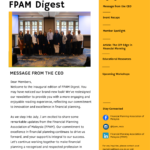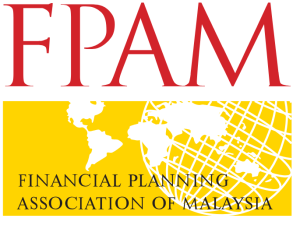
Future-Proofing Financial Planning
September 3, 2024
FPAM Digest – July 2024 Issue
September 13, 2024A Memoriam to Edwin P. Morrow II
Pioneer financial planner, trainer and educator based in Ohio, USA (Passed away 1 September 2023, aged 83)
By KP Bose Dasan
The story begins in 1987. Ed Morrow’s article appeared in a financial planning magazine from the USA. The magazine was referred to me by my insurance friend, Mr. Balasingam (now deceased). I shot a letter to Ed, and he said, “Come over to Middletown, Ohio.” And I did.
He was deeply invested in the professional development of financial planners. He worked on the computerisation of professional practice and developed software to prepare plans. His most successful software was called the Text Library System, which contained countless documents that planners could use in writing their plans. He had all the requisite qualifications, which included CLU, ChFC and CFP certifications, and was a life member of the Million Dollar Round Table.
I was saddened to hear of his passing, only recently. His story needs to be told.
His office was literally in the middle of Middletown, Ohio. It was very spacious, and he even had an adjoining house where he housed his interns. I was taken in as an intern. I remember being treated to a huge Italian dinner on my first day. That’s when I knew he had a passion for food.
Later, I realised that he also had a passion for opera, art collection and scuba diving. He had asked me for a recipe to make chicken curry. I got the recipe from a friend in London and gave Ed just the names of spices but not the quantities. He made a fine curry.
Financial planning was just becoming the in-thing in the insurance and mutual fund industries. Ed decided to invest in training financial planners. He had a great big dictionary in his personal room, which literally meant he was a man of letters.
He had a huge house with two garages, a swimming pool, a basement floor with a pool table and a great big octagon dinner table (which was made in Malaysia) and a huge TV room. It was then valued at US$300,000. Such a sized residence in Malaysia would run into a couple of millions. He used his premises to entertain planners and interns during their training.
Planners would come from all over America for detailed training sessions, usually a week long. They had to understand the software besides learning techniques in financial planning. Making a practice out of financial planning is a difficult proposition. To do a plan takes a bit of time, unlike making a sale of a financial product with backroom support given by large corporations.
To make matters more intricate, if you choose holistic, comprehensive financial planning as a revenue model with input from various other professionals, more time and expertise are needed. The financial planner is regarded as the quarterback orchestrating the development of the plan to meet various goals. To do this in sufficient numbers will be challenging. That was Ed’s goal—to help the practitioners.
My internship started with me following Ed to write interview notes as he visited his clients. That’s when I realised most homes in America start with their kitchen with their multi-faceted ‘Island‘, around which conversations are usually held.
After I had written the interview notes, it was verified with the client, and the client was subsequently given a fact-finding form for details to construct the income statement and net worth statement. The income statement identifies the critical cash flows during a year, which truly reflects possibilities for the client.
The net worth statement reflects the total assets and liabilities, which indicates how solvent or wealthy a client is. Growing the net worth of a client was a major focus for Ed. When you project your net worth over a period of ten to twenty years, assumptions become fundamental. Stating the assumptions is a critical part of the plan.
What does the future hold? The planner’s recommendations will impact the growth of net worth; the higher the net worth, the better. Tax planning and investment recommendations will make a huge difference to the final outcome. How much do you need to retire is a favourite calculation among financial planners.
A famous adage in financial planning is that the plan precedes the products and not the other way round. Just as each individual is different, financial circumstances and financial opportunities are different for each individual. Later in my reading, I discovered that rich people want to do the smartest thing possible with their money. That is the expertise needed by the financial planning community.
Ed had a radio show in Middletown, Ohio, in which I participated in one segment. He had a regular magazine called Money Talks, airing various issues pertaining to financial planning. I had many debates with Ed and gave him my perspective on what tax planning can do. He was very responsive to new ideas.
Ed wanted to expand his services across the world. He was in Malaysia and in the region, including China. He promoted his International Association of Registered Financial Consultants (IARFC). His 500+ articles, three books, 40 manuals and hundreds of presentations led to his international recognition as “the adviser to financial advisers”.
Ed Morrow did his part to promote financial literacy and the practice of financial planning. Financial planning is a noble idea and is much needed in all parts of the world. For his gallant contribution to the development of financial planning, we should applaud and award him.
Rest in peace, dear Ed. You have helped pave the way for the future of financial planning. Thank you.
About the Writer
KP Bose Dasan, 73, holds degrees in Economics from Universiti Malaya and an MBA from Cranfield University, but he values the education and experience he gained while working with the Inland Revenue Department Malaysia the most. Transitioning from a tax manager at Hanafiah Raslan Mohamad to running his own practice, he discovered that formal education alone isn’t enough, leading him to financial planning and eventually to a rewarding career in teaching.



